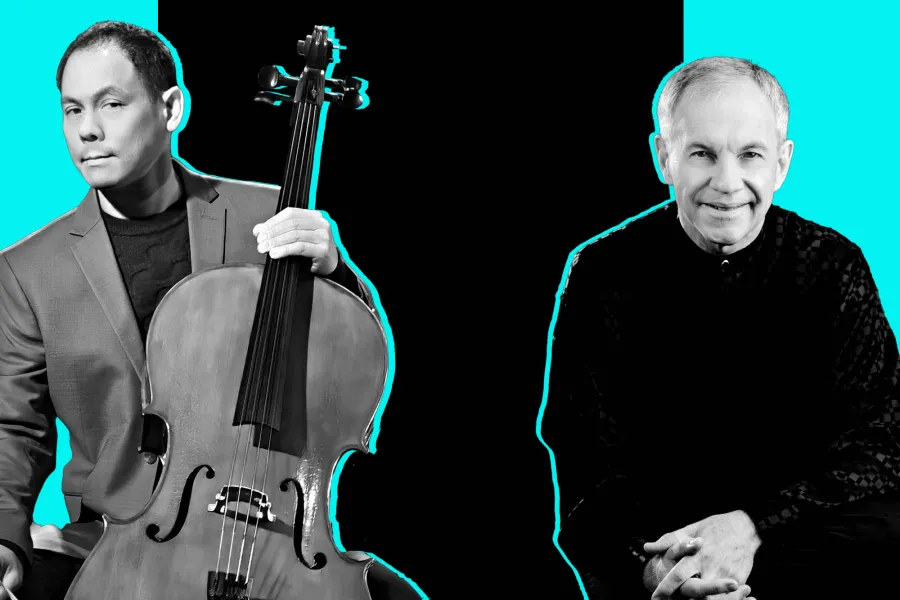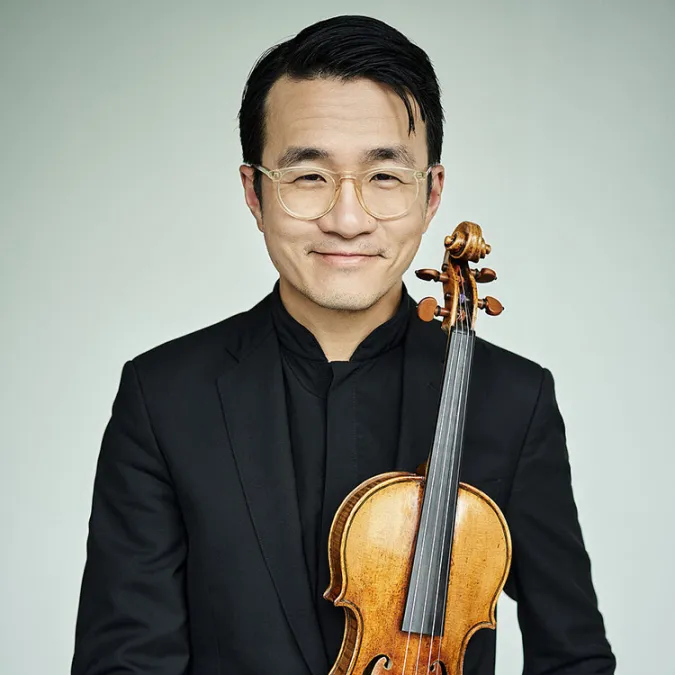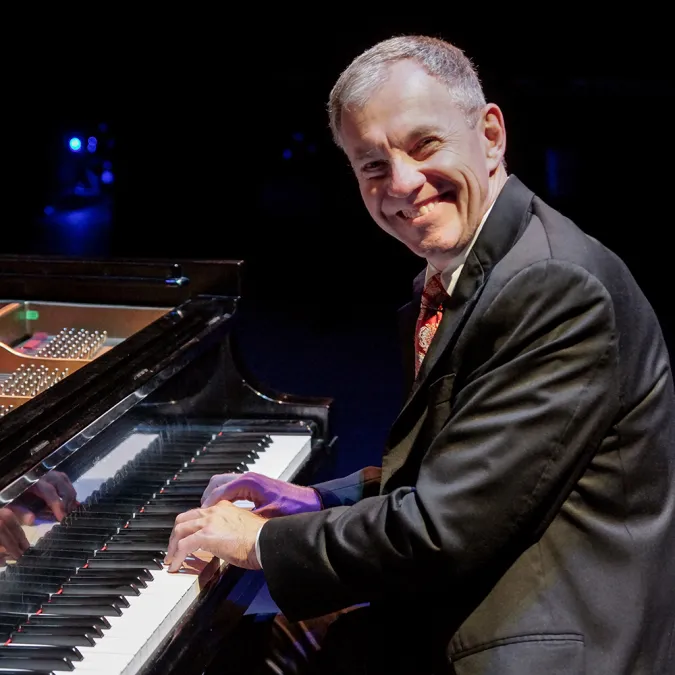
This Program will last about 100 minutes with one intermission.
Program
Reinhold Glière
8 Pieces, Op. 39
Prelude
Gavotte
Lullaby
Canzonetta
Intermezzo
Impromptu
Scherzo
Etude
Dmitri Shostakovich
Cello Sonata in D Minor, Op. 40
Allegro non troppo
Allegro
Largo
Allegro
intermission
Franz Schubert
Piano Trio No. 2 in E-flat Major, Op. 100
Allegro
Andante con moto
Scerzando, Allegro moderato
Allegro moderato
About the Program
Program Notes by Mark Bilyeu.
Reinhold Glière
8 Pieces, Op. 39
Born January 11, 1875, Kyiv, Ukraine
Died june 23, 1956, Moscow, Russia
Composed 1909
Duration 15 minutes
Russian composer Reinhold Glière studied with Taneyev and Hrimaly, and he shared a teacher with Prokofiev. Like so many Russians of his Romantic Soviet generation, he was inspired by Rimsky-Korsakov’s commitment to Russian folk music and his masterful orchestration skills. Unlike contemporaries like Shostiakovich and Prokofiev, Glière’s music kept primarily beneath the shadows of Rimsky, and so (also unlike his contemporaries) he received very little pushback from the Soviet government. His 8 Pieces is a unique blend of old and new, with movements reminiscent of Baroque dance suites like “Gavotte” and “Canzonetta” juxtaposed with Brahmsian titles like “Intermezzo” and “Impromptu.” No piece is longer than 3 minutes, and yet each is wonderfully individual reflecting on passion, mystery, and even a little joy.
Dmitri Shostakovich
Cello Sonata in D Minor, Op. 40
Born September 25, 1906, Saint Petersburg, Russia
Died August 9, 1975, Moscow, Russia
Composed 1934
Premiered December 25, 1934, Moscow
Duration 24 minutes
In 1934, Dmitri Shostakovich was on top of the world: his opera Lady Macbeth of Mtsensk District was a major success. The opera was playing in multiple cities to sold out audiences, one prominent critic wrote the opera “could only have been written by a Soviet composer brought up in the best traditions of Soviet culture” and yet other critics called it “a triumph for Soviet music” and “a brilliant opera.” One person who did not like it, however, was Joseph Stalin, who in 1935 saw the work, and publicly called it “muddle instead of music.” But, before that career-altering proclamation, Shostakovich wrote his sonata for cello and piano. You’d be forgiven if you think the first movement sounds like something taken from Beethoven’s sonatas—the form and musical content seem to hearken back to the Classical era. The second movement scherzo, with its insistent repeated notes, can only be Shostakovich, and the third movement’s long, husky, and sinewy lines have caused some commentators to speculate that a brief separation from his wife (he was having an affair with a young student) influenced this heartfelt largo. The final movement was written to showcase the composer’s own pianistic prowess, it even includes a concerto-eque cadenza. in fact, Shostakovich was performing this work on a tour with cellist Viktor Kubatsky (the work’s dedicatee) when Stalin attended his opera, and it was while performing this sonata that Stalin proclaimed him persona non grata in his Soviet homeland.
Franz Schubert
Piano Trio No. 2 in E-flat Major, Op. 100
Born January 31, 1797, Himmelpfortgrund, Vienna, Austria
Died November 19, 1828, Vienna, Austria
Composed 1827
Premiered Fall 1827
Duration 45 minutes
It was at a Vienna mansion called ‘The Red Hedgehog” where Franz Schubert’s second piano trio received its second performance. Three months earlier—and exactly one year before his death—the work was first heard at a house party celebrating the engagement of his longtime friend Josef von Spaun (there is a rather famous painting by Moritz von Schwind of Schubert at the piano, surrounded by dozens of houseguests; the house is Spaun’s). It is a devastating fact that very little of Schubert’s music was heard outside the homes of his friends during his lifetime; this created a domino effect which made selling his music to publishers very difficult, which in turn made supporting himself financially nearly impossible. It took the energies of von Spaun and many others to finally band together to put on an entire public concert of Schubert’s music - a feat never done during his lifetime. On March 25, 1828 (only 8 months before Schubert’s death) a lifelong dream of Schuber’s was realized, made possible by the free services of musicians, and the Austrian Philharmonic Society who donated the use of The Red Hedgehog for the evening. His friends sold out the concert, and took out an ad in the paper, calling him ‘the glorious German tone-poet” whose “powerfully intellectual, enchantingly lovely and original tone-poems have made him the favorite of the whole musical public.” Schubert chose the program, which included an all-male chorus, some songs, the first movement of a new string quartet, the premiere of Auf dem Strom, and his second piano trio. The four-movement work is unusually long, lasting nearly fifty minutes, with some movements having as many as 4 major themes, and the final movement clocking in at a whopping 748 bars. The second movement is based on a Swedish folk song—"Se solen sjunker" (Now the sun is setting)—which Schubert heard the visiting Swedish tenor Isak Albert Berg sing at a Vienna house party a year earlier. The work was a hit (and so was the concert, giving Schubert 300 gulden (very roughly about $4,500 in today’s USD) and was published by a Leipzig firm just before his death in November. It was to be the only work of his published outside of Vienna during his lifetime. Several months later, in January 1829, the Austrian Philharmonic programmed the work again, this time for a concert to raise funds for Schubert’s cemetery monument. Robert Schumann would describe the work as "an angry meteor blazing forth and outshining everything in the musical atmosphere of the time," a metaphor not just for the trio, but for Franz Schubert himself.
About The Artists
Andrew Wan

Andrew Wan was named concertmaster of the Orchestre Symphonique de Montréal (OSM) in 2008. As soloist, he has performed worldwide under conductors such as Rafael Payare, Kent Nagano, Maxim Vengerov, Vasily Petrenko, Bernard Labadie, Carlo Rizzi, Peter Oundjian, Xian Zhang, Michael Stern and James DePreist. He has played chamber music with artists such as the Juilliard Quartet, Vadim Repin, Marc-André Hamelin, Daniil Trifonov, Menahem Pressler, Jörg Widmann, Emanuel Ax, Johannes Moser, Arabella Steinbacher, James Ehnes, and Gil Shaham as a frequent artist at the Seattle Chamber Music, La Jolla Summerfest, Ottawa Chamberfest, Toronto Summer Music, Orford Musique, St. Prex, Colorado College and Olympic festivals. Wan performs regularly as guest concertmaster for the Pittsburgh, Houston, Indianapolis, National Arts Centre, Toronto and Vancouver Symphony orchestras.
Wan’s discography includes Grammy-nominated and Juno, Felix and Opus award-winning releases on the Analekta, Onyx, Bridge, and Naxos labels with the Seattle Chamber Music Society, New York’s Metropolis Ensemble, Charles Richard-Hamelin and the New Orford String Quartet. In the fall of 2015, he released a live recording of all three Saint-Saëns violin concerti with the OSM and Kent Nagano under the Analekta label to wide critical acclaim. His recent live album of works for violin and orchestra by Bernstein, Moussa and Ginastera with Nagano and the OSM won the 2021 Juno award for Best Classical Recording for Large Ensemble.
Wan enjoys a deep collaborative relationship with Canadian pianist Charles Richard-Hamelin, silver medalist of the 17th Chopin International Piano Competition, with whom he has recorded all ten Beethoven sonatas for piano and violin. Their second album of Beethoven's 1st, 2nd, 3rd and 5th Sonatas garnered the 2022 Juno award for Best Classical Recording for Small Ensemble. Their next recording featured the sonatas for violin and piano by Robert Schumann, released in the fall of 2022.
Wan graduated from The Juilliard School with Bachelor of Music, Master of Music and Artist Diploma degrees and is currently a member of the New Orford String Quartet, Associate Professor of Violin at the Schulich School of Music at McGill University, Artistic Director of the Prince Edward County Chamber Music Festival and for the 2017-18 season was Artistic Partner of the Edmonton Symphony Orchestra. In 2019, he won the Part-Time Teaching Award at the Schulich School of Music.
Andrew Wan performs on a 1744 Michel'Angelo Bergonzi violin, and gratefully acknowledges its loan from the David Sela Collection. He also enjoys the use of an 1860 Dominique Peccatte bow from Canimex.
Bion Tsang

Winner of an Avery Fisher Career Grant and the Bronze Medal in the International Tchaikovsky Competition, cellist Bion Tsang has appeared with the New York, Mexico City, Moscow, Busan and Hong Kong Philharmonic Orchestras, the Atlanta, Pacific, American and National Symphony Orchestras, the Saint Paul and Stuttgart Chamber Orchestras, the Hollywood Bowl Orchestra and the Taiwan National Orchestra. As a chamber musician, Mr. Tsang has collaborated with violinists Pamela Frank, Jaime Laredo, Cho-Liang Lin and Kyoko Takezawa, violist Michael Tree, cellist Yo-Yo Ma, bassist Gary Karr and pianist Leon Fleisher. He has been a frequent guest of the Chamber Music Societies of Boston, Brooklyn, Fort Worth and Seattle, Chamber Music International (Dallas), Da Camera of Houston, and performed at the festivals of Marlboro, Manchester, Portland and Tucson, the Bard Festival, Bravo! Colorado, and the Laurel Festival of the Arts, where he served as Artistic Director for ten years. Mr. Tsang received his BA from Harvard University and his MMA from Yale University, where he studied with Aldo Parisot. His other cello teachers included Ardyth Alton, Luis Garcia-Renart, William Pleeth, Channing Robbins and Leonard Rose. Mr. Tsang holds the Joe R. & Teresa Lozano Long Chair in Cello at UT.
Anton Nel

Winner of the 1987 Naumburg International Piano Competition at Carnegie Hall, Anton Nel continues to tour internationally as recitalist, concerto soloist, chamber musician and teacher. Highlights in the U.S. include performances with the Cleveland Orchestra, and the Chicago, San Francisco, Dallas, Seattle, and Detroit Symphonies as well as coast to coast recitals. Overseas he has appeared at the Wigmore Hall in London, the Concertgebouw in Amsterdam, Suntory Hall in Tokyo, and major concert halls in China, Korea and South Africa. He holds the Joe R. and Teresa Lozano Long Endowed Chair at the University of Texas at Austin where he heads the Division of Keyboard Studies. During the summers he is on the artist-faculties at the Aspen Music Festival and School, the Steans Institute at the Ravinia Festival, as well as the Orford Music Academy in Quebec. Mr. Nel also frequently performs as harpsichordist and fortepianist. His teachers include Adolph Hallis at the University of the Witwatersrand and Bela Siki and Frank Weinstock at the University of Cincinnati.
Upcoming Events

Miró Quartet
Featuring Masumi Per Rostad, viola
Johannes Brahms
String Quintet No. 1 in F Major, Op. 88
String Quintet No. 2 in G Major, Op. 111
Michael Begay
Viola Quintet (world premiere)
Monday, October 28, 7:30 p.m.
Bates Recital Hall
Triptych Trio
Wednesday, October 23, 7:30 p.m.
Bates Recital Hall
Symphony Orchestra
Saturday, October 26, 7:30 p.m.
Bates Recital Hall
Yamazalde Trio
Thursday, October 31, 7:30 p.m.
Bates Recital Hall
Clara & Johannes
John Largess, viola & Tamar Sanikidze, piano
Thrusday, November 7, 7:30 p.m.
Bates Recital Hall
Event Details
$10–20
All University of Texas at Austin students are allowed one free ticket as long as they are available. Student tickets must be picked up at the Box Office with valid student I.D. Seating is unassigned.
If you are a patron with ADA needs, please email tickets@mail.music.utexas.edu and we will reserve ADA seating for you.

